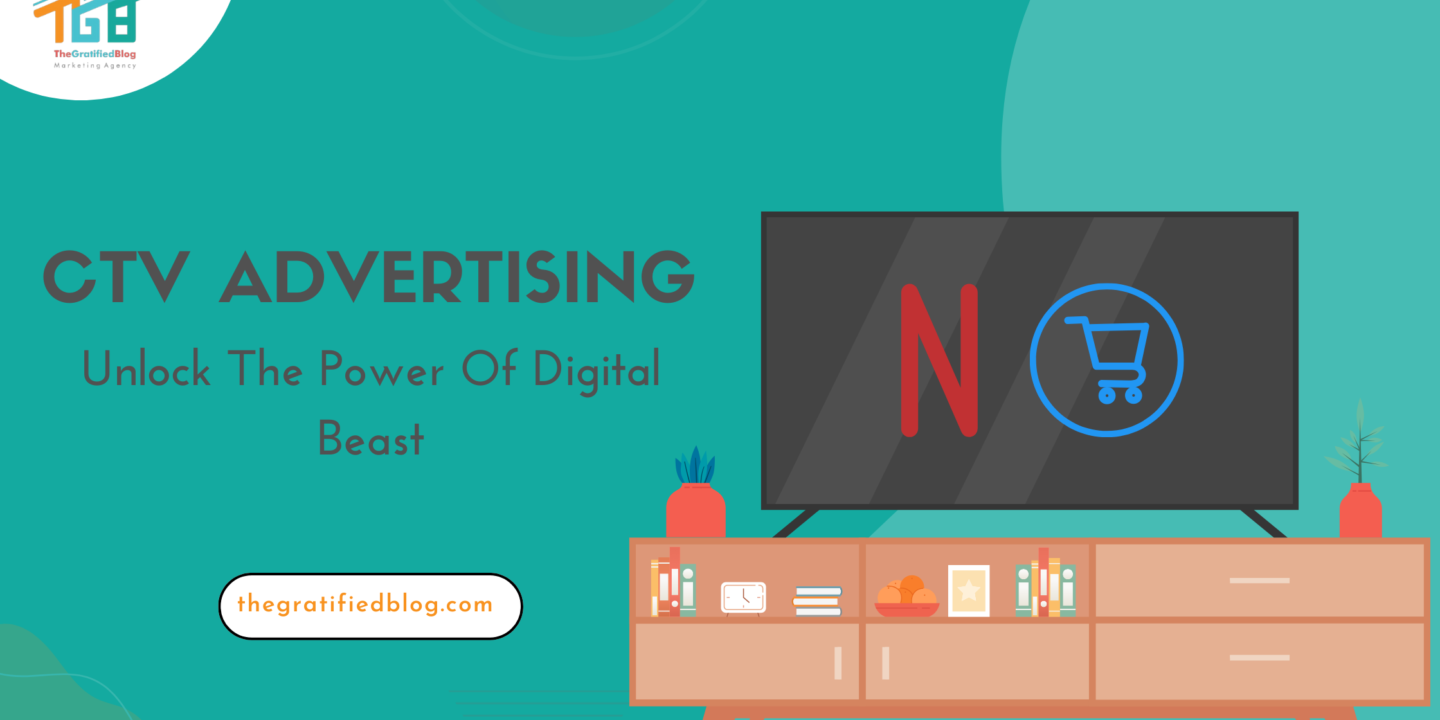
In today’s fast-changing digital marketing scene, a term that has gained significant traction is CTV advertising. Connected TV (CTV) advertising refers to the delivery of ads through internet-connected television sets, offering a dynamic blend of the reach of traditional TV with the precision of digital marketing.
As more consumers shift from cable to streaming services, CTV advertising has become an essential strategy for brands looking to engage with audiences in a more targeted and measurable way.
In this blog, we will explore the intricacies of CTV advertising, its benefits, strategies, challenges, and much more to help you harness its full potential for your marketing campaigns.
So, let’s get started:
What Is CTV Advertising?
Connected TV (CTV) advertising refers to the delivery of digital ads through internet-connected television sets. This includes smart TVs and devices like Roku, Amazon Fire Stick, Apple TV, and gaming consoles that connect to a TV to stream content via the internet.
Unlike traditional TV advertising, where ads are broadcast to a broad audience, CTV advertising leverages digital technology to target specific demographics, interests, and behaviors, providing a more personalized and practical advertising experience.
How Does CTV Advertising Work?

CTV advertising operates through internet-connected devices that deliver video content to television screens. The process involves several key components and steps to ensure ads are effectively targeted, delivered, and measured.
Ad Creation
- Content Development: Advertisers create video ads tailored to their target audience. These can range from short commercials to longer, interactive experiences.
- Ad Formats: Various formats include pre-roll (ads before content), mid-roll (ads during content), post-roll (ads after content), and display ads overlaying the video content.
Targeting
- Audience Segmentation: Advertisers define specific audience segments they want to reach using demographics, viewing behavior, interests, and location.
- Data Sources: Data can be collected from first-party sources (e.g., website interactions) or third-party sources (e.g., data brokers) to refine targeting accuracy.
Programmatic Buying
- Ad Exchanges: Advertisers use programmatic platforms and ad exchanges to automate the buying and placement of ads. This allows real-time bidding, ensuring ads are served to the right audience at the right time.
- Demand-Side Platforms (DSPs): Advertisers utilize DSPs to manage multiple ad exchanges and data partners, streamlining ad buying.
Ad Delivery
- Streaming Services: Ads are delivered through streaming platforms like Netflix, Hulu, Amazon Prime Video, and other apps available on CTV devices.
- Real-Time Bidding (RTB): During the streaming session, RTB technology determines which ads to serve based on the highest bidder for the specific target audience.
Benefits Of CTV Advertising
- Targeted Advertising: CTV advertising allows precise targeting based on demographics, interests, and behaviors, ensuring ads are shown to the most relevant audience. This targeting improves the effectiveness of campaigns by delivering personalized messages to viewers who are more likely to engage and convert.
- Higher Engagement: Compared to traditional TV ads, CTV ads often result in higher engagement because they are more targeted and relevant to viewers’ interests. Non-skippable ads and interactive elements encourage viewers to interact with the content, increasing brand awareness and message retention.
- Measurable Results: CTV advertising provides detailed analytics and measurement tools that track ad performance, such as impressions, completion rates, click-through rates, and conversions. These tools offer valuable insights into campaign effectiveness and allow advertisers to optimize strategies for better results.
- Cost-Effectiveness: With CTV advertising, advertisers can optimize their ad spend by targeting specific audience segments, reducing the wastage of uninterested viewers. The ability to track ROI through measurable results ensures that every dollar spent on CTV ads contributes to tangible business outcomes, making it a cost-effective marketing channel.
Having learned about CTV advertising, its operations, and advantages, let’s examine how it differs from traditional TV advertising.
How CTV Advertising Differs From Other Traditional TV Advertising

CTV vs. OTT Advertising
Connected TV (CTV) advertising and Over-the-Top (OTT) advertising are often used interchangeably but differ. CTV refers specifically to ads delivered through internet-connected TVs, including smart TVs and streaming devices.
On the other hand, OTT encompasses all Content distributed via the internet without a standard TV subscription, including CTV and streaming services on mobile devices and computers.
While CTV ads target viewers on TV screens, OTT ads reach audiences across various devices. CTV ads benefit from larger screens and a more immersive viewing experience, while OTT ads have a broader reach across multiple platforms.
CTV vs. Linear TV Advertising
Linear TV advertising refers to traditional ads broadcasted on scheduled channels like cable and satellite networks. The critical difference with CTV advertising is how content is delivered and consumed.
Linear TV ads follow a fixed schedule and are broadcast to a broad audience with limited targeting options. In contrast, CTV ads are delivered via internet-connected devices, allowing for precise targeting based on demographics, interests, and behaviors. CTV ads also offer interactivity and measurable results, unlike linear TV ads, which are one-way broadcasts.
CTV vs. Addressable TV Advertising
Addressable TV advertising is a subset of CTV advertising focusing on delivering targeted ads to specific households or individuals. While CTV ads target viewers based on broader criteria like demographics and interests, addressable TV ads use advanced data and technology to personalize ads for individual households or even specific viewers within a household.
This level of targeting ensures that ads are highly relevant and practical, leading to better engagement and ROI. CTV advertising generally encompasses a broader range of options beyond addressable targeting, making it a versatile choice for advertisers.
Now, let’s explore the essential metrics for gauging CTV advertising effectiveness and examine the obstacles faced in this advertising domain.
Key Metrics To Measure CTV Advertising Success

- Impressions: Impressions in CTV advertising refer to the number of times an ad is displayed on viewers’ screens. They indicate the ad’s reach and how many potential viewers were exposed to the message. Tracking impressions helps advertisers understand the visibility and exposure of their ads to the target audience.
- Completion Rates: The completion rates gauge the portion of viewers who watch an entire ad without skipping or exiting before it finishes. Higher completion rates indicate viewers engaged with the content and absorbed the message. This metric is crucial for evaluating ad effectiveness and viewer interest in the ad’s content.
- Click-Through Rates (CTR): CTR tracks the percentage of viewers who interact with an ad by clicking on it after viewing, indicating the ad’s ability to capture interest and engagement and the effectiveness of the call to action. A higher CTR isuggeststhat the ad resonated with viewers and motivated them to take further action, such as visiting a website or purchasing.
- Conversion Rates: Conversion rates track the percentage of viewers who completed a desired action after interacting with the ad, such as signing up for a newsletter, purchasing, or requesting more information. They measure the ad’s impact on driving specific outcomes and are a crucial indicator of campaign success in achieving business objectives.
- Return on Ad Spend (ROAS): ROAS calculates the revenue generated from ad spend, providing insights into the profitability of CTV advertising campaigns. By comparing the revenue generated to the cost of running the ads, advertisers can determine the efficiency and effectiveness of their investment. A positive ROAS indicates that the ad campaign generated more revenue than the cost, making it a valuable metric for assessing campaign profitability and ROI.
Challenges In CTV Advertising

- Ad Fraud: Ad fraud refers to deceptive practices that aim to manipulate ad metrics or generate fake impressions, clicks, or conversions. In CTV advertising, ad fraud can occur through techniques like bot traffic or spoofed devices, leading to inflated metrics and wasted ad spending. Advertisers must implement fraud detection tools and verification services to combat ad fraud and ensure ad campaigns reach genuine viewers.
- Fragmentation: Fragmentation in CTV advertising refers to the diverse ecosystem of devices, platforms, and content providers, leading to challenges in ad delivery and measurement. With various CTV devices and streaming services, advertisers face complexity targeting and optimizing campaigns across multiple channels. Fragmentation can result in inefficient ad spend and difficulty reaching the desired audience consistently, requiring advertisers to adopt strategies that streamline campaign management and audience targeting.
- Viewer Privacy: Viewer privacy is a critical concern in CTV advertising due to collecting personal data for targeting and measurement purposes. Advertisers must comply with privacy regulations like GDPR and CCPA, ensuring transparency and consent in data collection practices. Balancing personalized ads with respect for viewer privacy is essential to maintaining trust and compliance, necessitating robust data protection measures and ethical data handling practices in CTV advertising campaigns.
FAQs

Q1. What Is CTV Advertising?
A. CTV advertising refers to delivering ads through internet-connected TV devices, offering targeted and measurable campaigns on platforms like smart TVs and streaming services.
Q2. How Does CTV Advertising Differ From Traditional TV Ads?
A. Unlike traditional TV ads with broad targeting, CTV ads target specific demographics and behaviors, provide higher engagement with interactive features, and offer detailed analytics for performance tracking.
Q3. What Metrics Are Used To Measure CTV Advertising Success?
A. Key metrics include impressions (ad views), completion rates (ad watched fully), click-through rates (CTR), conversion rates, and return on ad spend to gauge effectiveness and ROI.
Conclusion
As CTV advertising continues to gain traction and grow in importance, marketers must understand its key terms and strategies. With this knowledge, you’ll be well-prepared to capitalize on the growing opportunities in CTV advertising and maximize your marketing impact in the digital age.
However, if you still have any questions related to the blog, please feel free to leave them in the comments sections below. We will be happy to answer them.
Thanks for reading 🙂








No Comments